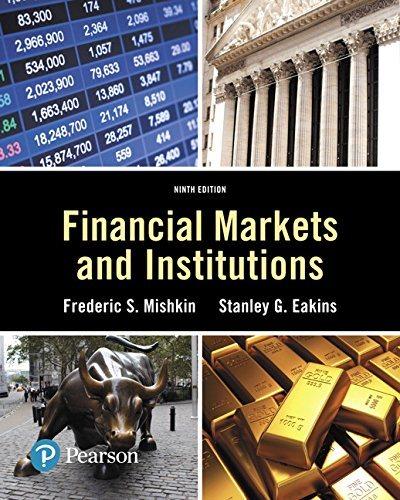Question
Some questions from a past exam in Corporate Finance. 1.You have been promised $1,000 by Joe Shmoe in 1 year. Shmoe investments has a market-beta
Some questions from a past exam in Corporate Finance.
1.You have been promised $1,000 by Joe Shmoe in 1 year. Shmoe investments has a market-beta of 2. If the expected rate of return on the market is 6% and the expected rate of return on risk-free bonds is 3%, what is the PV of this promise?
2.A firm that costs $100 today will be worth (next year) either $50, $100, or $150, with probabilities 1/3, 1/3, and 1/3, respectively. Although the firm has a cost of capital of 33.33%, it expects to pay only an interest rate of 20% for a 1-year bond that raises $50 today. What is the promised payment on the bond? What is the expected rate of return on the equity if the firm is financed with this bond?
3. Is discounting EBITDA usually better or worse than discounting net income when you want to value a firm with a PV projection?
4.To obtain project cash flows from the financials, holding capital structure constant, how can you quickly use information from the cash flow statement to extract the proper cash flows?
5.If the annualized Sharpe ratio of your strategy is 1, and if your strategy expects to deliver 10% above the risk-free rate per year, then what do you expect the unannalized Sharpe ratio to be over 10 years?
6.Are the following statements true or false or maybe? Explain.
1If there is inflation in an otherwise perfect capital market, then the decision whether to adopt a project depends on the identity of the project owner.
2Is the real after-tax rate of return on short-term Treasuries typically positive?
3From a perspective of extracting the cash flows for an NPV analysis, the depreciation figure from the income statement can substitute well for the depreciation figure from the cash-flow statement.
4If there are no synergies or externalities between two merging firms, the combined P/E ratio is the value-weighted average of its two constituent P/E ratios.
5What is the worst problem with using P/E comparables? In 3 sentence or less, how can you remedy this?
6Prudent Man Rules prohibit many institutional investors from holding stocks that pay dividends, because dividends are double-taxed.
(7) Shareholder value maximization means that firms should maximize P/E ratios.
8A firm in the 30% tax bracket that suddenly and unexpectedly announces that it will increase its leverage by $1 billion forever should see additional present value of its cor- porate income tax savings to account for a value increase of a little over $300 million.
9Assume that a firm that is worth $20B will get into financial distress if it has debt and the enterprise value falls below $2B. The probability if this happening is 10%. If it does, customers will flee, which will cost it 5% of its business. In counterbalancing the benefits of debt, should the firm use 5% as its expected cost of bankruptcy that today?
Step by Step Solution
There are 3 Steps involved in it
Step: 1

Get Instant Access to Expert-Tailored Solutions
See step-by-step solutions with expert insights and AI powered tools for academic success
Step: 2

Step: 3

Ace Your Homework with AI
Get the answers you need in no time with our AI-driven, step-by-step assistance
Get Started


